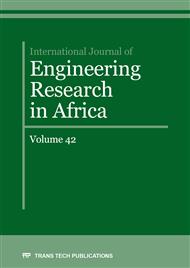[1]
L. Berredjem, Recycling demolished concrete as solution for sustainable development. Doctorate thesis university of Annaba, Algeria (2009).
Google Scholar
[2]
N.D. Oikonomou, Recycled concrete aggregates, cement and concrete composites, 27 (2), pp.315-318. (2005).
DOI: 10.1016/j.cemconcomp.2004.02.020
Google Scholar
[3]
T.H. Douara, Physical and chemical characteristics of recycled aggregates and natural aggregates, article at SBEIDCO meeting, ENSET - Oran, Algeria, 12-14 October (2009).
Google Scholar
[4]
A. Grondin , Study of the physical and mechanical characteristics of concretes of recycled aggregates of concrete. Insa strasbourg, iut robert schuman, imfs, CEBTP Alsace, France (2011).
Google Scholar
[5]
A.K. Padmini, K. Ramamurthy And M.S Mathews, Influence of parent concrete on the properties of recycled aggregate concrete. Construction and Building Materials, pp.829-836 (2009).
DOI: 10.1016/j.conbuildmat.2008.03.006
Google Scholar
[6]
H. Meftah, N. Arabi, Recycled aggregates moistened behaviors of fresh and hardened concrete. University meetings of civil engineering, Tlemcen Algeria (2011).
Google Scholar
[7]
L. Butler, J.S west and S. L. Tighe, The effect of recycled concrete aggregate properties on the bond strength between rca concrete and steel reinforcement. Cement and Concrete Research, volume 41, number 10, pp.1037-1049 (2011).
DOI: 10.1016/j.cemconres.2011.06.004
Google Scholar
[8]
R. Chakradhara, S. K. Bhattacharyya and S. V. Barai, Influence of field recycled coarse aggregate on properties of concrete. Materials and Structures, volume 44, number 1, pp.205-220 (2011).
DOI: 10.1617/s11527-010-9620-x
Google Scholar
[9]
G. Fathifazl, A. Abbas, A. G. Razaqpur, O.B. Isgor, B. Fournier, and S. Foo, New mixture proportioning method for concrete made with coarse recycled concrete aggregate. Journal of Materials in Civil Engineering, volume 21, number 10, pp.601-611 (2009).
DOI: 10.1061/(asce)0899-1561(2009)21:10(601)
Google Scholar
[10]
S.M. Levy, P. Helene, Durability of recycled aggregates concrete: a safe way to sustainable development. Cement and Concrete Research, volume 34, number 11, pp.1975-1980 (2004).
DOI: 10.1016/j.cemconres.2004.02.009
Google Scholar
[11]
M. Malesev, V. Radonjanin and S. Marinkovic, Recycled concrete as aggregate for structural concrete production. Sustainability, volume 2, number 5, pp.1204-25 (2010).
DOI: 10.3390/su2051204
Google Scholar
[12]
Z. Zhao, S. Remond, D. Damidot & W. Xu, Influence of hardened cement paste content on the water absorption of fine recycled concrete aggregates, Journal of Sustainable Cement-Based Materials, 2:3-4, pp.186-203, (2013).
DOI: 10.1080/21650373.2013.812942
Google Scholar
[13]
K. Sagoe-Crentsil, T. Brown, and A. H Taylor, Performance of concrete made with commercially produced coarse recycled concrete aggregate. Cement and concrete research, volume 31, number 5, pp.707-712 (2001).
DOI: 10.1016/s0008-8846(00)00476-2
Google Scholar
[14]
V. W. Y. Tam, C. M. Tam, Diversifying two-stage mixing approach (tsma) for recycled aggregate concrete: tsmas and tsmasc. Construction and building materials, volume 22, number 10, pp.2068-77 (2008).
DOI: 10.1016/j.conbuildmat.2007.07.024
Google Scholar
[15]
T.C. Hansen, Recycled aggregates and recycled aggregate concrete second state-of-the-art report developments, Materials and structures p.1945–1985 (1986).
DOI: 10.1007/bf02472036
Google Scholar
[16]
W. George, E. Ghorbel, Eurocode 2: application to recycled gravel concretes. 31st meeting of the AUGC, E.N.S. cachan, France (2013).
Google Scholar
[17]
M. S. De Juan, P. A. Gutierrez, Study on the influence of attached mortar content on the properties of recycled concrete aggregate. Construction and Building Materials, volume 23, number 2, pp.872-7 (2009).
DOI: 10.1016/j.conbuildmat.2008.04.012
Google Scholar
[18]
M. Etxeberria, E. Vazquez, A. Mari and M. Barra, Influence of amount of recycled coarse aggregates and production process on properties of recycled aggregate concrete. Cement and Concrete Research, volume 37, number 5, pp.735-742 (2007).
DOI: 10.1016/j.cemconres.2007.02.002
Google Scholar
[19]
V.W.Y. Tam, K. Wang and C.M. Tam, Assessing relationships among properties of demolished concrete, recycled aggregate and recycled aggregate concrete using regression analysis. Journal of Hazardous materials (2008).
DOI: 10.1016/j.jhazmat.2007.07.061
Google Scholar
[20]
V. W. Y. Tam, X. F. Gao and C.M. Tam, Micro-structural analysis of recycled aggregate concrete produced from two-stage mixing approach. Cement and Concrete Research (2005).
DOI: 10.1016/j.cemconres.2004.10.025
Google Scholar
[21]
V. Spaeth, A. Djerbi Tegguer, Polymer based treatments applied on recycled concrete aggregates. Advanced Materials Research (2013).
DOI: 10.4028/www.scientific.net/amr.687.514
Google Scholar
[22]
A. Djerbi Tegguer, Determining the water absorption of recycled aggregates utilizing hydrostatic weighing approach. Construction and Building Materials 27(1), p.112–116 (2012).
DOI: 10.1016/j.conbuildmat.2011.08.018
Google Scholar
[23]
French Standard EN 1097-6, Tests for determining the mechanical and physical properties of aggregates - Part 6: Determination of the true density and the coefficient of water absorption. AFNOR (1996).
Google Scholar
[24]
L. Ferreira, Influence of the pre-saturation of recycled coarse concrete aggregates on concrete properties, Magazine of Concrete Research, volume 63 issue 8, pp.617-627 (2011).
DOI: 10.1680/macr.2011.63.8.617
Google Scholar
[25]
M. Salgues, P. Devillers, J.C Souche and E. Garcia-Diaz, Influence of initial saturation degree of recycled aggregates on fresh cement paste characteristics: consequences on recycled concrete properties. European journal of environmental and civil engineering, ed. Lavoisier, pp.1-15 (2016).
DOI: 10.1080/19648189.2016.1245630
Google Scholar


